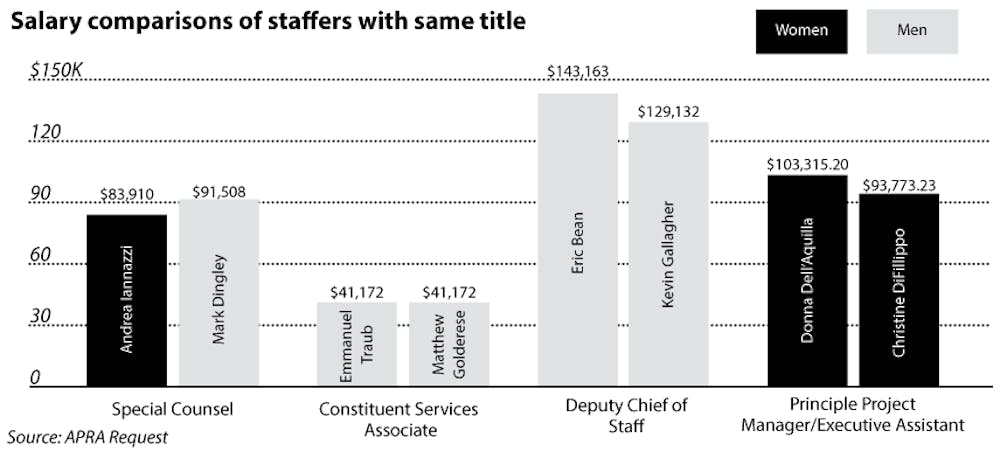Gov. Gina Raimondo, now a month into her first term, broke the glass ceiling by becoming the first female governor of Rhode Island. Throughout her campaign, Raimondo made promises to forge a path for other women to rise to leadership positions.
In a position paper on her campaign’s website, Raimondo said she would “promote a culture of paycheck fairness” by creating both an anonymous tip line for women to report noncompliance with the state’s wage discrimination laws and an equal pay certification for businesses “that show a commitment to equal pay practices.”
Despite this stated commitment, a 14 percent gender wage gap remains in the governor’s office, GoLocalProv reported.
There are many reasons for salary discrepancies between men and women that don’t necessarily point to gender discrimination, said Anna Aizer, associate professor of economics and public policy. With this in mind, The Herald took a closer look at the salaries of Raimondo’s staffers to investigate the gender wage gap and its relationship to possible gender discrimination.
The Herald obtained the names, titles and salaries of everyone Raimondo has appointed through an Access to Public Records Act request.
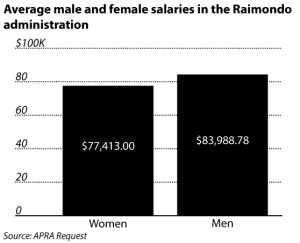
Upon analyzing this data, sent by Andrea Iannazzi, special counsel to the governor, The Herald found only an 8 percent pay gap between men and women. Further, “nearly 60 percent of (Raimondo’s) staff (members) are women,” Marie Aberger, press secretary for the governor, wrote in an email to The Herald.
The Herald then cross-referenced the names and titles in the APRA response with the Jan. 6 press release in which Raimondo announced her team.
When focusing on these particular appointments, there is an 11 percent wage gap between the average male and female salaries.
There was a clear outlier in the salary data: Meredith Curren, director of appointments. She is paid only $5,000 a year, bringing down the average female salary significantly. Once Curren was taken out of the data set, there were nearly even numbers of men and women, and only a 4.4 percent wage gap.
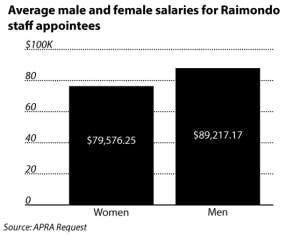
When labor economists test for salary discrepancies between genders, they control for occupation, level of schooling and experience, Aizer said.
Controlling for occupation can be complicated because women are sometimes only considered for positions requiring less skill. While “some people could argue that that is a form of discrimination,” it’s different than paying equally skilled people doing equally difficult jobs different salaries, Aizer said.
Looking to control for these occupational differences in skill level, The Herald removed non-technical jobs such as Office Manager, Scheduler, Protocol Manager and Special Assistant to the Governor, to see what discrepancies between salaries might remain. With three men and two women in such positions, 11 female and nine male staffers were left in the data pool, yielding an 11.7 percent wage gap.
Typically, more women end up in these non-technical positions, Aizer said. As a part of the four-part “Women at Work” series for the New York Times, Sheryl Sandberg and Adam Grant wrote about the numerous studies showing that women frequently end up doing “office housework” even in high-up positions.
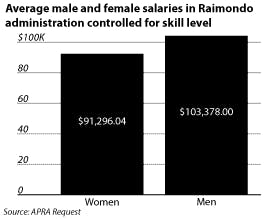
But in the governor’s office, there were more men doing non-technical jobs than women, which brought down the average male salary and made it seem as though the wage gap were smaller. When these non-technical positions are removed from the analysis, the average male salary goes up by nearly 16 percent, while the average female salary only increases by 7 percent.
The GoLocalProv article that discussed the wage gap points out that, in terms of salary, the “only woman in the top five position in the Raimondo executive office is Claire Richards,” who stayed on through multiple previous administrations dating back to former Gov. Lincoln Almond.
The fact that she stayed from a previous administration is not a reason to throw her out as a data point, Aizer said.
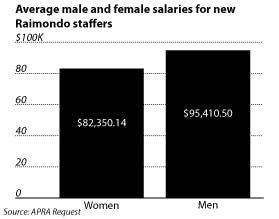
But when the inherited members of Raimondo’s team — Donna Dell’Aquila, Christine DiFillippo, Claire Richards, Abby Swienton, David Cruise and John Cucco — are removed from the analysis, the wage gap increases to nearly 14 percent, the number GoLocalProv originally reported.
Additionally, the highest-paid man and woman in the governor’s office — Claire Richards and David Cruise — were both inherited. So when the inherited members of Raimondo’s team are removed, the highest-paid man becomes Chief of Staff Stephen Neuman and the highest-paid woman becomes Deputy Counsel Amy Moses, with a wage gap of nearly 29 percent between them.
The simplest way to control for occupation, Aizer said, is to examine employees with the same title. On Raimondo’s team, several staffers have identical titles. These employees sometimes have the exact same salary, but in other cases, salary discrepancies exist. A strong relationship was not evident between the gender of the staff member and the salary discrepancies present in this case.
These differences in salary despite identical titles are justifiable, Aizer said. Depending on how much a person was making beforehand, the administration might have had to offer him or her more money to join Raimondo’s team, Aizer added.
But “previous salary is not a bona fide reason for paying men and women differently for the same work,” Michele Leber, chair of the National Committee on Pay Equity, told GoLocalProv.
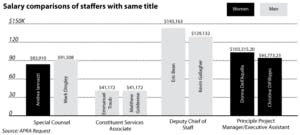
Another way to analyze salaries under the Raimondo administration is to look at past administrations’ teams. Rhode Island Public Radio reported the names, titles and salaries of former Gov. Lincoln Chafee’s ’75 P’14 P’17 original staff in 2010.
These numbers initially present a 14 percent wage gap between men and women. But when non-technical jobs are removed from the analysis, though only seven women and 13 men remain, the wage gap drops to 8 percent.
When the data is controlled for skill level, the gender wage gap under the Raimondo administration widens to almost 12 percent. By comparison, the wage gap under the Chafee administration was 8 percent when controlled for skill level. In addition, when the inherited members of Raimondo’s team are removed from the analysis, the wage gap widens to almost 14 percent on average and 29 percent among her highest-paid employees.
But the Raimondo administration continues to affirm its commitment to gender parity.
“Initiatives to promote women in leadership are not just important for women but essential to creating opportunities for all Rhode Island families and strengthening our economy,” Aberger wrote of the administration’s take on the gender pay gap.
Raimondo’s position paper on paycheck fairness bleakly states that “median earnings for women are less than those for men in 264 of 265 major occupation categories.”
[gallery link="file" ids="2815121,2815123,2815127,2815129,2815130,2815131"]

